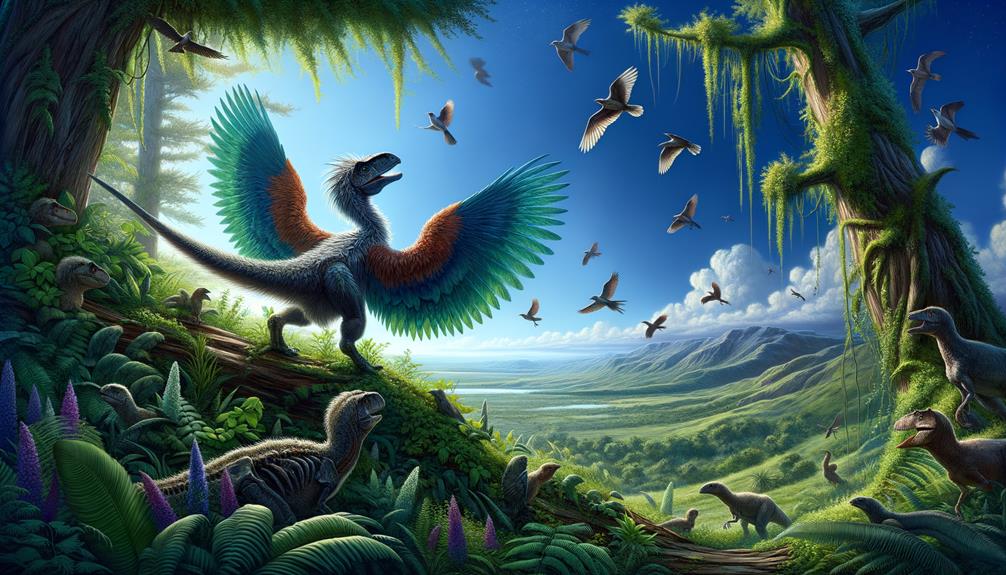Lizard evolutionary radiations, such as those seen in the Anolis lizards of the Greater Antilles, offer a fascinating glimpse into adaptive radiation. These lizards diversify rapidly, both morphologically and ecologically, exploiting various available niches. Initially, diversification rates surge due to the abundance of unoccupied opportunities. Differences in limb length and habitat-specific morphologies demonstrate their ecomorphological adaptations. When they colonize new environments, especially islands, it accelerates their diversification by reducing competition and predation pressures. When island-derived species return to the mainland, they often outcompete established species. Understanding these dynamics reveals how lizards continue to evolve and adapt extensively. Their intriguing evolutionary journey still holds many secrets waiting to be uncovered.
Key Takeaways
Adaptive radiations in lizards, such as Anolis, occur when new ecological niches become available, leading to rapid lineage and morphological diversification.
The Caribbean islands have been hotbeds for Anolis lizard adaptive radiations, resulting in high morphological disparity and net diversification rates.
In lizards, ecomorphological adaptations, including limb length variations, reflect specific habitat use and ecological niches.
When island-derived Anolis clades return to the mainland, they often outcompete native species, demonstrating their competitive edge.
Dietary specializations, such as variations in head size and jaw mechanics, drive diversification in lizard species on oceanic islands.
Adaptive Radiation Dynamics
In the early stages of adaptive radiation, we see a rapid surge in lineage and morphological diversification, as exemplified by the anoles of the Greater Antilles. This initial burst of diversification leads to significant ecological and morphological differences as these organisms quickly exploit available niches. The rates of diversification are higher at the onset, driven by the abundance of unoccupied ecological opportunities.
The pace and pattern of adaptive radiations can differ significantly between island and mainland contexts. Island systems, like the Greater Antilles, often exhibit more pronounced early bursts of diversification due to their isolated and resource-rich environments. In contrast, mainland radiations may proceed at a more gradual pace, influenced by pre-existing ecological competition. Interestingly, a mainland clade derived from island ancestors may exhibit adaptive strategies distinct from those of its mainland predecessors, reflecting their unique evolutionary paths.
Furthermore, the observed disconnect between lineage and phenotypic diversification in adaptive radiations suggests complex underlying processes. Elucidating these processes is crucial for understanding how evolutionary dynamics shape the diversity of life. As a result, the study of adaptive radiation dynamics provides valuable insights into the mechanisms driving biodiversity.
Colonization of New Environments

The dynamics of adaptive radiation set the stage for understanding how lizards, particularly Anolis species, colonize new environments, leading to remarkable evolutionary radiations on both islands and mainlands. The colonization history of Anolis lizards reveals that their origin in South America and subsequent migration to the Caribbean islands provided substantial ecological opportunities, facilitating adaptive radiations.
On islands, Anolis lizards exhibit significant morphological disparity due to the less intense competitive and predatory environment compared to the mainland. However, when these island-derived clades returned to the mainland, they displayed competitive superiority over incumbent mainland radiations. This underscores the intricate dynamics of colonization history, where mainland Anolis communities now support up to 15 sympatric species, mirroring island diversity.
Islands acted as catalysts for these adaptive radiations, providing an ecological opportunity that led to high morphological disparity and notable net diversification rates in both island and mainland Anolis lizards. This reflects the dynamic interplay between ecological pressures and adaptive potential, resulting in a profound evolutionary narrative.
Ecomorphological Adaptations
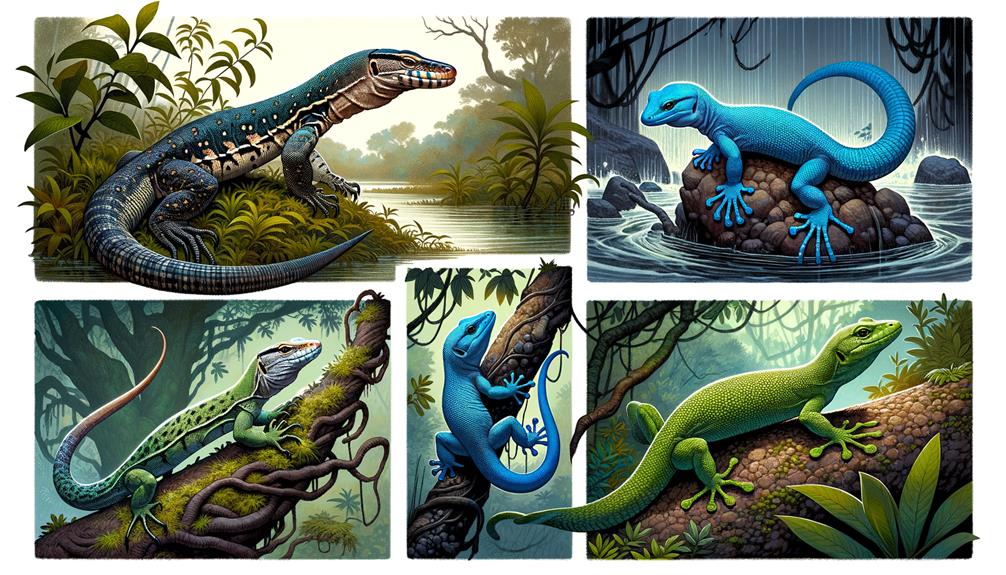
When examining the adaptability of lizards, I look at how differences in limb length help them thrive in various environments. The unique physical features that allow them to succeed in specific habitats showcase the intricate connection between an organism's form and its function. Moreover, the specialized diets of some lizards reveal how evolutionary pressures have shaped their feeding strategies to make the most of available resources.
Limb Length Variations
Limb length variations in lizards showcase a remarkable example of ecomorphological adaptation, where species have developed specialized traits to thrive in distinct environments. For instance, lizards that live in trees, such as those in the Anolis genus, typically have longer limbs, which helps them navigate the complex canopy. This adaptation is in stark contrast to terrestrial species, which have shorter limbs that are better suited for moving efficiently on the ground.
In the Caribbean, Anolis lizards have undergone rapid and repeated adaptive radiation, resulting in limb length differences that are closely tied to their ecological niches. These variations have emerged on different islands, driven by the unique habitat structures and resource availability in each location. Island populations often exhibit pronounced shifts in limb proportions compared to their mainland counterparts, highlighting the significant impact of island-specific ecological pressures.
The divergence in limb length among these populations highlights a critical aspect of ecomorphological adaptation: the direct link between physical traits and ecological function. By examining these variations, we can gain valuable insights into the evolutionary processes that shape biodiversity. The study of limb length in lizards offers a compelling example of how morphological traits evolve in response to environmental challenges, providing a deeper understanding of adaptive radiation and speciation.
Habitat-Specific Morphologies
In the realm of habitat-specific morphologies, certain lizard species have evolved unique physical traits that are directly tied to their ecological niches. This underscores the intricate relationship between form and function in evolutionary biology. For example, arboreal species like many Anolis lizards have developed long limbs and adhesive toe pads, which facilitate their movement through trees. In contrast, saxicolous species have short limbs and flattened bodies, adaptations that enhance their ability to navigate rocky substrates.
These ecomorphological adaptations have enabled lizards to exploit a wide range of microhabitats, introducing significant ecological and morphological disparity. The rate of morphological diversification is often driven by ecological opportunity and adaptive pressures. For instance, the diverse ecomorphs of Anolis lizards across Caribbean islands illustrate how different species evolve to occupy specific niches and ecological opportunities over time.
Mainland anole communities, which can support up to 15 sympatric species, exhibit comparable levels of ecomorphological diversity through parallel evolution. Similarly, the Hemidactylus geckos in Peninsular India have undergone repeated and independent shifts to terrestrial ecomorphs as open habitats and grasslands emerged. This pattern of morphological diversification highlights the pivotal role of ecological opportunity in shaping species evolution.
Dietary Specializations
How do lizards' dietary specializations manifest through distinct ecomorphological adaptations that enable them to exploit diverse food resources? An analysis of morphological data reveals that variations in head size, jaw mechanics, and dentition are crucial. For instance, herbivorous lizards, such as the marine iguanas of the Galápagos Islands, have evolved enlarged, flattened heads and serrated teeth, which are essential for grazing on algae. In contrast, carnivorous skinks from the Caribbean islands have developed large, powerful jaws and specialized teeth, optimized for capturing and processing prey.
The varied physical characteristics observed in these lizards highlight their ecological traits and the ecological diversity within their habitats. This diversity reflects the broad range of ecological niches they inhabit. In the Caribbean, lizard communities exhibit a remarkable array of dietary specialists, ranging from insectivores to vertebrate predators, each adapted to distinct ecological niches.
These dietary specializations have significantly contributed to species diversification and adaptive radiations on oceanic islands. The ecomorphological relationships between these lizards and their environments demonstrate how dietary adaptations facilitate the exploitation of available ecological opportunities. This diversification underscores the dynamic interplay between dietary specializations and the evolutionary trajectories of these remarkable reptiles.
Morphological Evolution Rates
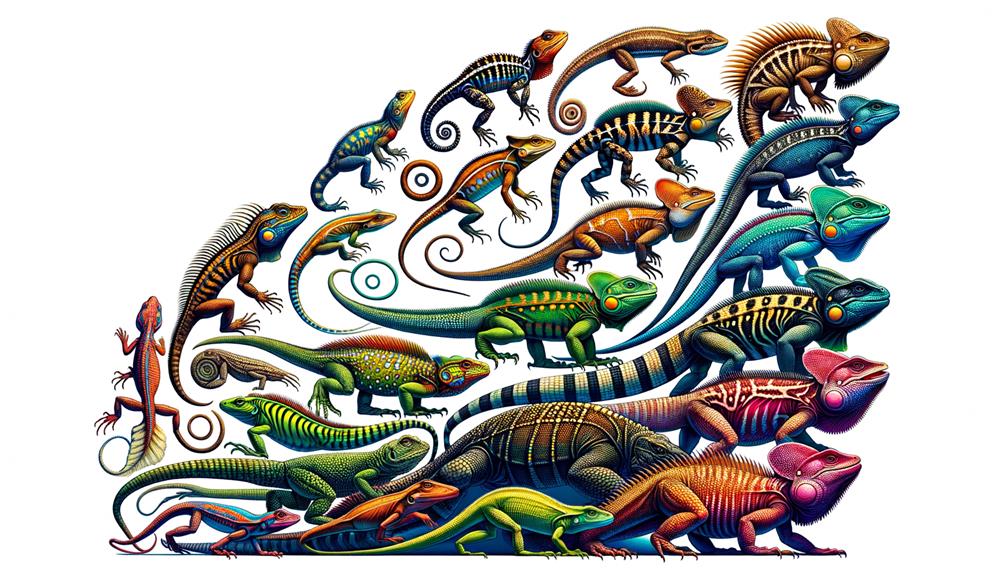
Understanding the rates of morphological evolution in lizards reveals a complex interplay between rapid anatomical changes and taxonomic diversification, challenging traditional views of adaptive radiation. The evolutionary exuberance of insular species shows that morphological and ecological disparity are not always coupled with taxonomic diversity. In fact, continental radiations can result in significant ecological and morphological diversity, as highlighted by mainland and island evolutionary studies.
A pattern of extreme convergence, as noted by Harmon et al., demonstrates how similar ecological niches can lead to remarkably similar morphologies despite disparate evolutionary lineages. This underscores the heterogeneity in lizard evolution. For instance, the phylogenetic pattern of extreme disparity in very different evolutionary contexts highlights the varying rates of morphological and ecological trait evolution. Analyzing these patterns reveals that the timing and rate of morphological evolution often do not align with periods of increased taxonomic diversification.
The origin of snakes, characterized by the fastest anatomical changes in reptile history, serves as a prime example of this dissociation. Rapid morphological evolution did not coincide with high taxonomic or molecular evolution rates, posing intriguing questions for future research.
Lineage Diversification Patterns
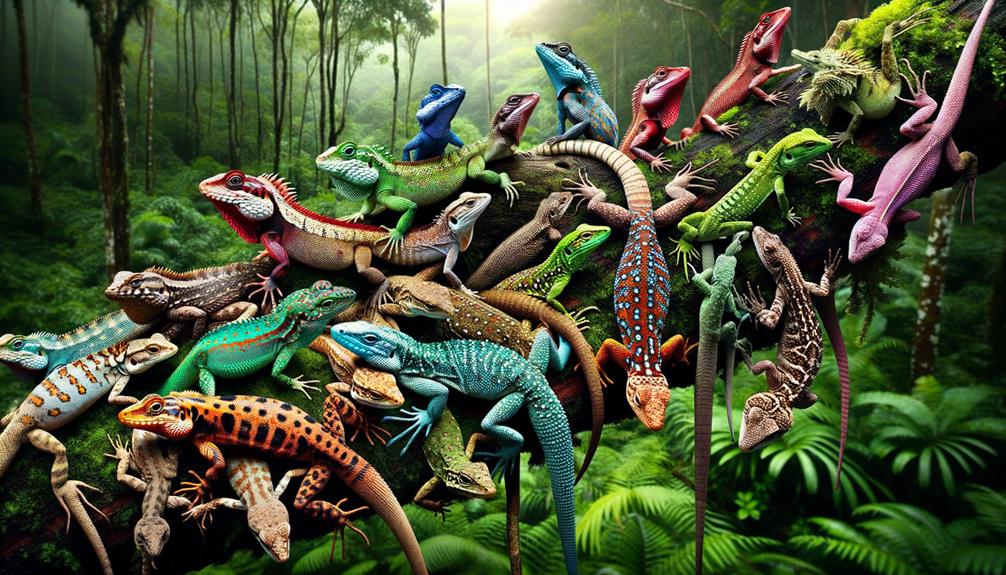
Exploring lineage diversification patterns reveals that adaptive radiations, particularly on islands, drive rapid and complex evolutionary trajectories, often surpassing those observed on continents. Islands act as crucibles of evolution, fostering unique ecological diversity through isolated environments. Anole lizards exemplify this phenomenon, with their lineage diversification peaking early in their adaptive radiation, as seen in the Greater Antilles. These island radiations exhibit remarkable diversification dynamics, producing varied morphological adaptations to distinct ecological niches.
The paleogeographic colonization of anoles, originating in South America and subsequently spreading to the Greater Antilles, southern Lesser Antilles, and mainland Central America, highlights the intricate interplay between island and mainland diversification. Despite mainland anoles achieving comparable ecological diversity, the evolutionary trajectories of island anoles tend to be steeper. When island-derived radiations encounter mainland incumbents, the former often dominate, illustrating the robust adaptive potential forged in insular environments.
The predatory environment also plays a vital role, influencing both the pace and outcome of diversification. Island environments, through their isolation and unique selection pressures, catalyze rapid lineage diversification, reflecting the dynamic and multifaceted nature of adaptive radiation. Understanding these patterns offers valuable insights into the mechanisms shaping ecological diversity and evolutionary success.
Convergence in Morphospace
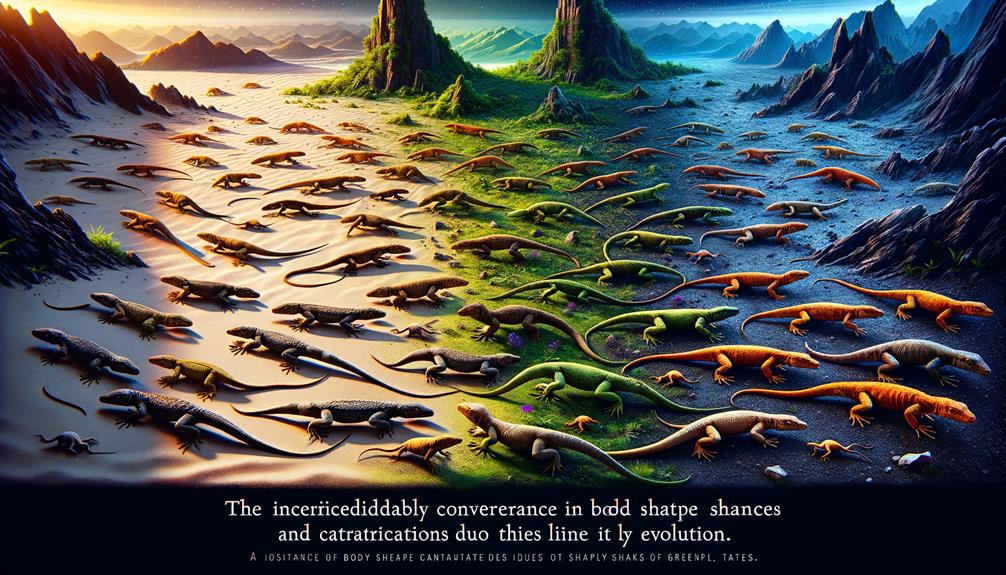
Morphological convergence in lizard adaptive radiations highlights the strong selective pressures driving distinct lineages towards similar ecomorphs, particularly evident in Anolis lizards on Caribbean islands. These lizards repeatedly evolve ecomorphs adapted to specific perch diameters and heights. Within this genus, we observe striking ecological diversity, with 11-15 sympatric species coexisting on the mainland. This diversity is highlighted by differences in lamella count and perch use.
The rates of evolution in morphology vary greatly between island and mainland radiations. Island radiations often exhibit rapid phenotypic change early on. When plotted using the R package, warmer colors indicate faster rates of morphological evolution. This creates detailed imagery, helping us understand the dynamics of these evolutionary processes.
| Parameter | Observation |
|---|---|
| Lamella Count | Higher in island species |
| Perch Diameter | Variable across habitats |
| Morphological Rates | Warmer colors = Faster |
| Ecological Diversity | Rich in the Caribbean |
Interactions between island-derived and mainland lizard clades show that island clades often dominate due to different evolutionary trajectories. These trajectories enable them to achieve significant ecological and morphological disparity. The convergence within island and mainland habitats reveals how different evolutionary paths can lead to similar adaptive solutions, driven by high rates of natural selection.
Frequently Asked Questions
What Is the Origin and Evolutionary Radiation of Reptiles?
I find the origin of reptiles fascinating – 310 million years ago, they emerged from early amniotes. Following the Permian-Triassic extinction, reptiles underwent a rapid evolutionary radiation, giving rise to diverse lineages like archosaurs and turtles, which showcased remarkable anatomical changes and varying rates of evolution.
What Are the Adaptive Radiation of Reptiles?
Adaptive radiation in reptiles is a fascinating process where species rapidly diversify into new ecological niches. This phenomenon involves the evolution of distinct traits that enable reptiles to exploit different environments. I've studied how this dynamic interplay between evolution and ecological opportunity drives remarkable morphological and behavioral adaptations.
What Is the Evolutionary Radiation?
Evolutionary radiation occurs when a single ancestral species rapidly diversifies into multiple distinct species, driven by access to new resources or geographic regions. This process highlights the dynamics of speciation and phenotypic evolution, offering insights into the factors that drive biodiversity.
What Does the Evidence Suggest Regarding the Evolution of Body Types of Anole Lizards on the Different Islands?
When it comes to anole lizard body types on different islands, the evidence suggests they've developed distinct forms, each tailored to its specific environment. In essence, they've undergone remarkable adaptations to thrive in their unique ecological niches.



